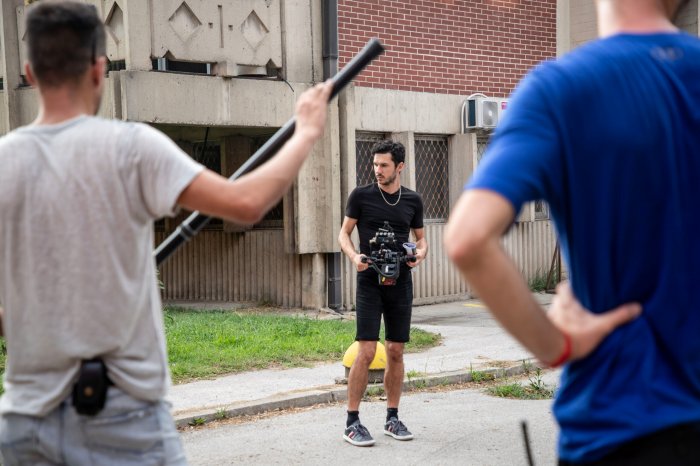Stylized Aches|“Norwegian Wood” is visually stunning, emotionally resonant
BY GARY M. KRAMER
In his ravishing adaptation of Haruki Murakami’s bestseller “Norwegian Wood,” writer and director Trân Anh Hùng conveys extraordinary emotion and sensuality. When the main character, Watanabe (Kenichi Matsuyama), describes a “vague knot of air inside me,” viewers can practically feel his grief.
Highly stylized, Hùng’s outstanding visuals express the internal feelings and tactile senses of the characters. He makes palpable the texture of a park bench and the feeling of running a hand along an outdoor railing. Viewers can feel the heat of the sun as it beats down on the sleeping Watanabe’s bare chest.
The celebrated Vietnamese filmmaker (“The Scent of Green Papaya”) also skillfully depicts the characters’ tortured romantic conflicts. A few years after the unexpected suicide of their mutual friend Kizuki (Kengo Kora) in 1967, Watanabe and Naoko (Rinko Kikuchi) reconnect and give in to their mutual attraction. On her 20th birthday, Naoko sleeps with Watanabe, ending her virginity. The couple’s budding relationship, however, abruptly halts when Naoko retreats to a sanatorium in the mountains, saying her grief over Kizuki makes it impossible for her to relate to others.
Despite Watanabe’s passionate attachment to her, he soon meets another student, Midori (Kiko Mizuhara), who flirts with him. The prospect of a relationship with her intrigues him.
Hùng films these couplings with dazzling visuals that aptly communicate the intense desires of each character. As Watanabe and Midori have a conversation about love, the camera oscillates back and forth between them, almost anticipating the kiss that eventually unites them. Another remarkable sequence tracks Watanabe down a corridor and up a staircase after he receives an exhilarating letter from Naoko. Perhaps the most spellbinding episode is a five minute long tracking shot that chronicles Naoko’s early morning confession to Watanabe in a field.
The drama in “Norwegian Wood” stems primarily from the despair each character feels over unrequited love. The conversations are frank. Naoko talks earnestly about sex, while Midori has a more comic approach toward the topic, one of many that distinguish Watanabe’s possible lovers, one of whom represents the past; the other, the future.
Watanabe is anxious to be with Naoko, but she is uneasy about being in a relationship. He also contemplates being with Midori, who sends him mixed signals as well, claiming she has a boyfriend. Bad timing is a common thread through each of the romantic adventures, as each character grapples with their past, present, and future relationships.
Hùng films much of the action using voiceovers, memories, and flashbacks to provide a prismatic view of the characters. He also narrates judiciously. In one scene, Watanabe cuts his hand at work. The aftermath of the accident is seen and discussed, but the event and what prompted it are less clear. Such ambiguity pervades “Norwegian Wood.”
The filmmaker also deftly employs sound and silence to imbue scenes with meaning. Several shots feature Watanabe and Naoko standing against a tree in the wind, moments freighted with the characters’ unspoken sexual tension and loss. In another scene, rain beating against a window underscores Naoko’s heartbreak. The discordant score by Radiohead’s Johnny Greenwood complements a breathtaking sequence in which the crashing of waves signifies the tremendous grief Watanabe feels after the death of a character.
Music plays an important part in “Norwegian Wood.” The title song, sung by Naoko’s friend Reiko (Reika Kirishima), makes Naoko cry and prompts one of her painful confessions. Readers of the novel will recall that the song was used in the book to trigger Watanabe’s memories.
If there is one element that Hùng fails to do justice to, it is the era’s backdrop of social unrest. While there are a few early scenes of Watanabe caught up in student protests, the force of social change is largely absent from the film.
Hùng’s emphasis is on nature, and this is beautifully illustrated throughout “Norwegian Wood.” There are many scenes in outdoor settings in which natural formations reflect the emotional states of the characters. Working with cinematographer Mark Lee Ping Bin, Hùng features stunning shots of Watanabe and Naoko coupling in verdant fields that mirror their passion and of an agonized Watanabe along the shore’s rocks and caves. Hùng composes every frame like a gorgeous still photograph.
The film’s period details are also excellent. The costumes — especially Watanabe’s collection of patterned shirts — and set design contribute to the film’s overall visual achievement.
Matsuyama is superb in the role of a sensitive young man whose emotions run deep. As Naoko, Kikuchi (an Oscar nominee for “Babel” a few years back) makes her pain resonate.
Viewers, however, will best remember Hùng’s unparalleled visuals as well as the deliberately open ending, a finish that is true to the bestselling novel.
Essentials:
NORWEGIAN WOOD
Directed by Trần Anh Hùng
In Japanese with English subtitles
Soda Pictures and Red Flag Releasing
Opens Jan. 6
IFC Center
323 Sixth Ave. at W. Third St.


































